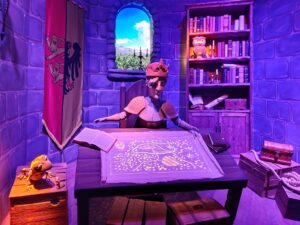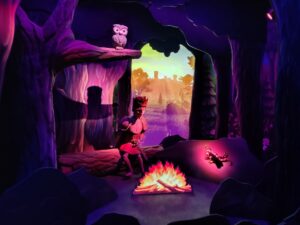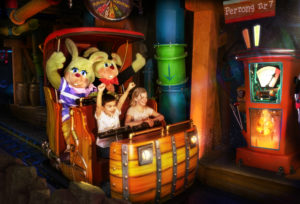
It is sad but true, all good things must come to an end. So is the case for Het Arsenaal (Vlissingen, Zeeland – Netherlands), as in early August word got out that it would be closing its doors after short notice. September 30th would be visitors’ last chance to pet rays, explore the Pirates’ Den and experience Blackbeard’s Revenge after 28 years of operation.
A Short History of Het Arsenaal
Het Arsenaal (The Arsenal) is located in the city of Vlissingen. This port city is famous for their ship-building and is also the birthplace of the famous Dutch admiral Michiel de Ruyter (1607-1676). Het Arsenaal is part of a larger entertainment complex and is a historic building with the name referring to its origins. The original Arsenaal was completed in 1823 and functioned as an artillery magazine until 1870. It was built on the foundation of an unfinished hospital for Napoleon Bonaparte’s army, who lost the war before it could be completed. A plaque on Het Arsenaal reminds visitors of this event. Regardless, the Dutch Department of Defense had no use for it anymore by 1980 and traded the building to the city of Vlissingen who promptly began making plans for it to boost tourism.
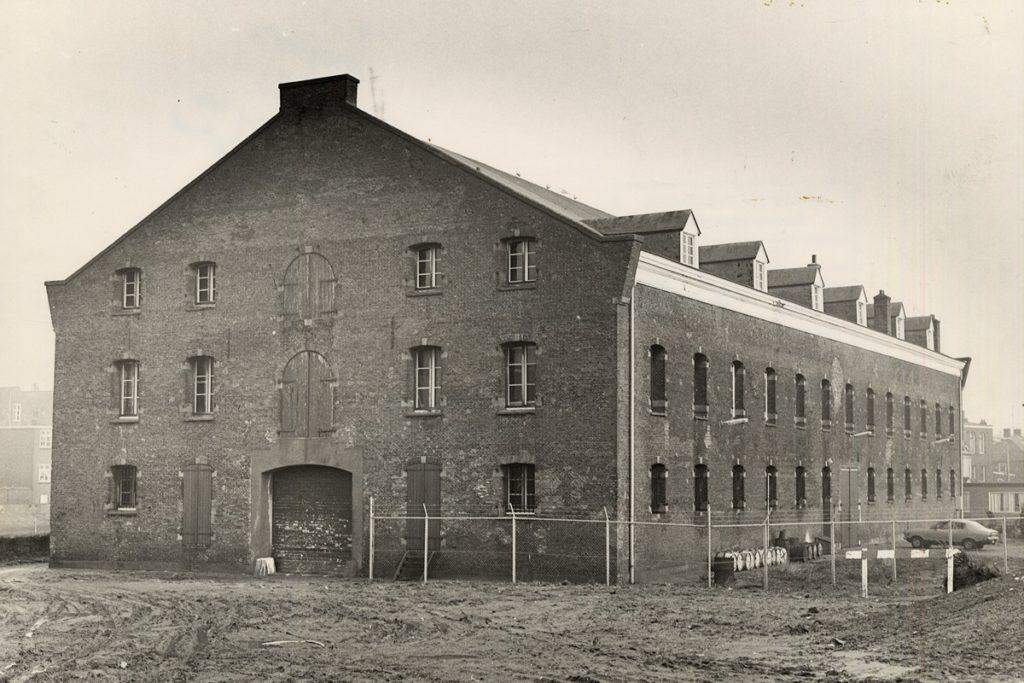
An initiative group was set up and the first idea to construct a ‘’marine themed attraction’’ was presented in 1985. While the main focus was to restore Het Arsenaal to its former glory and to incorporate a marine museum, plans were quickly expanded. Het Arsenaal was to become part of a larger complex, which would also feature a theatre, apartments and an observation tower in order to meet the wishes of the city of Vlissingen. It was even considered to expand the complex to the Westerschelde (the estuary right in front of Het Arsenaal) with a pier. However, budget cuts in 1989 prompted it to be scrapped, bringing the expected costs down to roughly ƒ 20 million (€9.1 million). The Dutch design firm Hypsos was hired to conceptualize the inside of Het Arsenaal. They came up with 3 ‘’stories’’, one for each floor of the building and all relating to a different aspect of the sea.
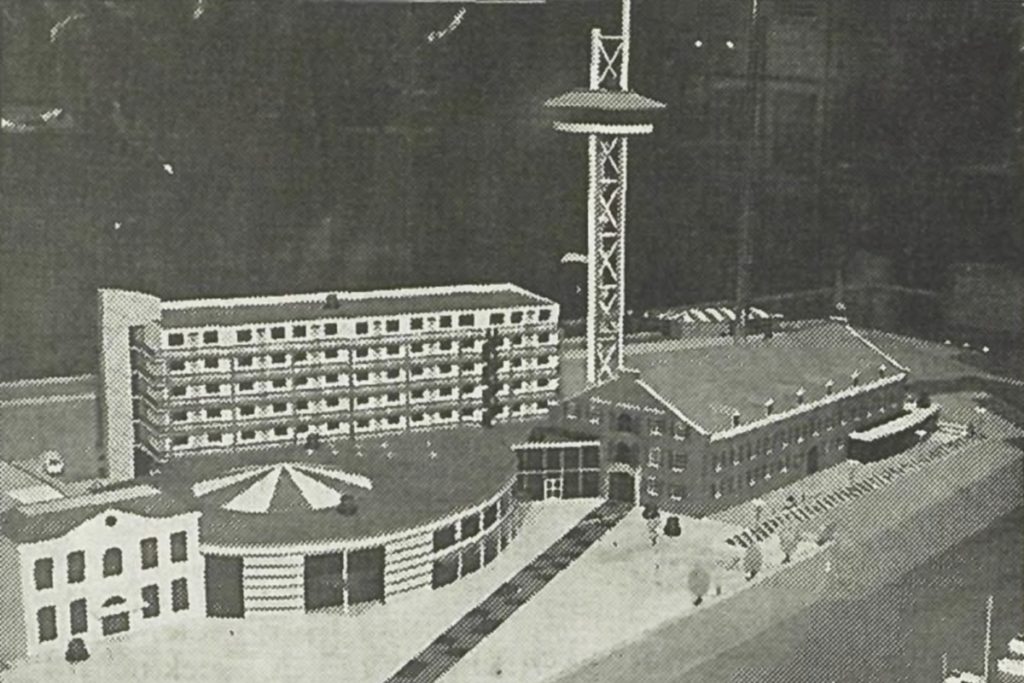
The second (and top) floor, where the adventure starts, would be all about ships, featuring lots of impressive miniatures and the ‘Vlootshow’, a show with miniature ships on a track. Descending to the first floor, focus would shift towards representing life aboard, reinforced by the Scheepssimulator (Ship Simulator). The ground floor, called Onderwaterwereld (Underwater World), would revolve entirely around marine life. It would feature aquaria and a fish restaurant. Finally, the observation tower would take guests up in the air, giving them a view over the Westerschelde and the ability to tune in on marine radio communication.
Originally, more attractions were planned, including a dark ride in which guests would take seat in a clam shell shaped vehicle and explore the bottom of the sea. So while Hypsos had to cut back on some ideas due to budget constraints, construction could finally begin in 1991. The complex was actually completed in phases. The 65 meter high observation tower (with a viewing height at 45 meters) was completed in July of 1992 and could be visited early, acting as a preview for the soon to be opened complex.
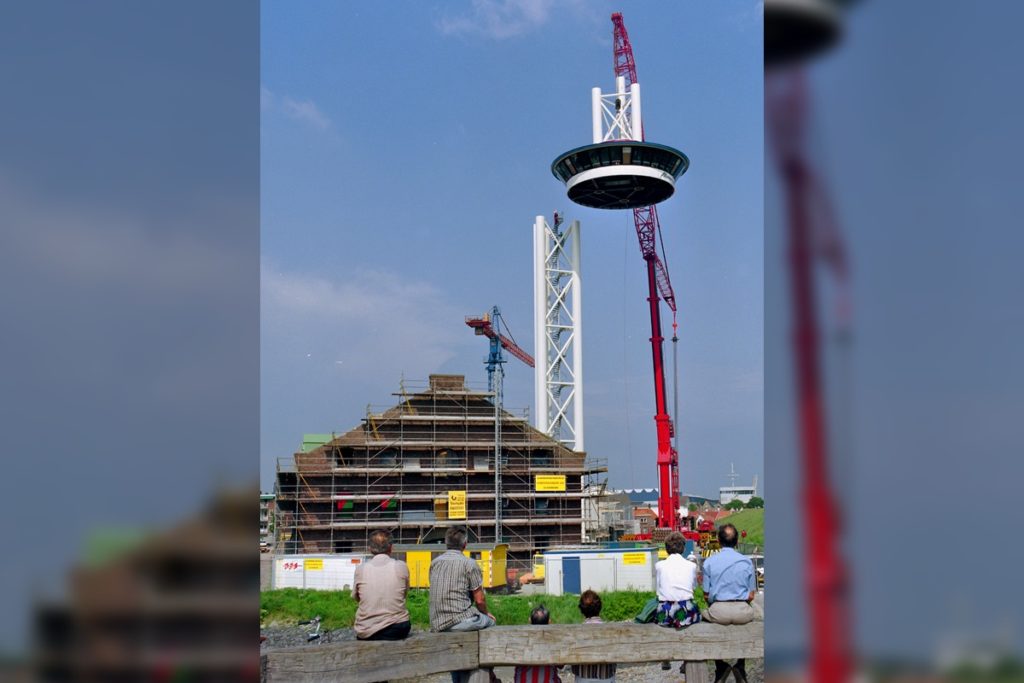
On May 28th 1993 the time had finally come for Het Arsenaal to open to the public. Though traditional museum lovers were sceptical of the concept, it turned out to be an appealing day out for families and Het Arsenaal quickly became a must-do when visiting Zeeland, attracting about 200,000 visitors a year.
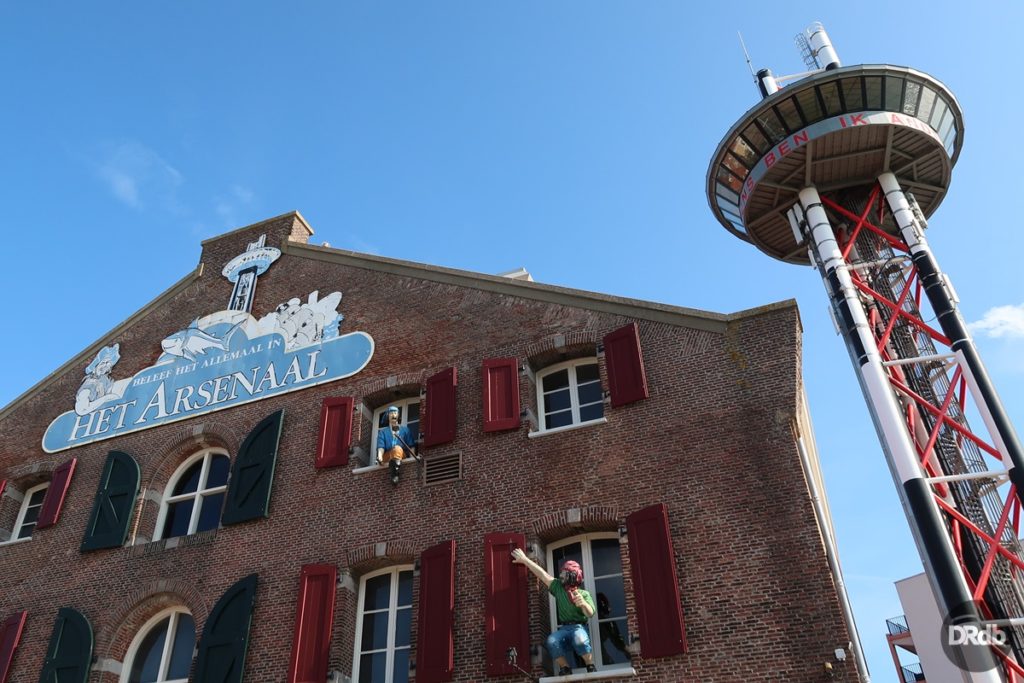
Simulator in 1993: Titanic
The Scheepssimulator opened with the park itself in 1993. An alternative name, ‘Schipbreuk’ (Shipwreck), was also used. While details regarding the ride experience seem to have been lost to time, it was themed to the sinking of the Titanic, without a doubt the most infamous ship disaster in history. The queue consisted of a hallway made to look like one from the ship, with animatronic characters behind windows acting out various professions. Once in a while a group was let into the pre-show for a meeting with the captain in the wheelhouse.

Next, the 10 minute show would start, with a staff member directing visitors towards the simulator in which they had to stand upright and even wear life jackets, ready to undergo the shipwreck experience. Unlike one would assume, the simulator did not face a projection screen. Instead a large diorama featuring scale models rising up from the cellar was featured, similar to an animatronic show with characters rising and falling. Special effects were also utilised such as fans, water sprayers and lights on the ceiling to mimic a starry night sky. These aspects certainly made this a one of a kind experience.

In the original plans by Hypsos, riders were to leave the simulator on their right-hand side by stepping into a lifeboat. This small capacity boat would only have enough space for a few riders, forcing them to split up into smaller groups. It would spin around on a crane in a small circular room and presumably take guests to the other side where they would exit the ride. This final part was not realised, possibly due to capacity and / or budget problems. Instead when the show was over, visitors would simply leave the simulator on the right and end up at the ‘Kombuis’ (Galley) bistro after walking through a short hallway.
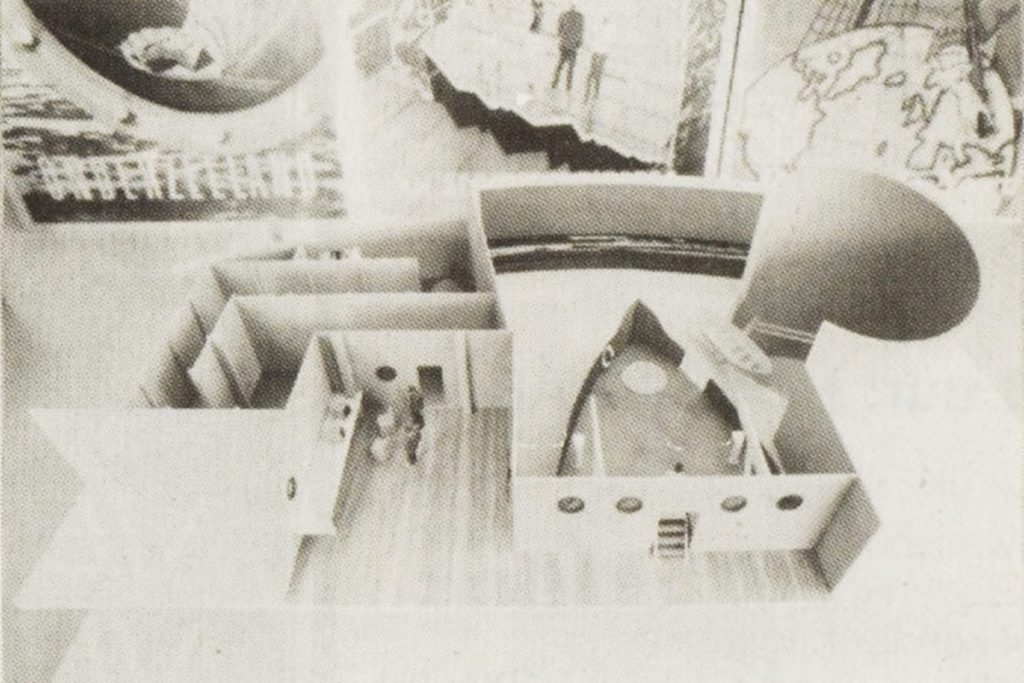
Simulator in 2000: Blackbeard’s Revenge
Even with the museum’s success in the early years, it was decided to revise Het Arsenaal every few years in order to keep the experience from getting stale and encourage repeat visits. The first major change happened in 1996 with part of the first floor being converted into the ‘Piratenhol’ (Pirate’s Den), a pirate themed haunted house walkthrough.

Following up on the pirate theme introduced in 1996 and to combat the Titanic ride ‘losing its shine’, the simulator was reworked in 2000 and advertised as a major new attraction. It became known as ‘De Wraak van Kapitein Zwartbaard’ (Captain Blackbeard’s Revenge), with Blackbeard playing the role of main character and a mascot of sorts for Het Arsenaal. The first change was made to the entrance as it now lead to an entirely new waiting room made to look like a cargo hold.
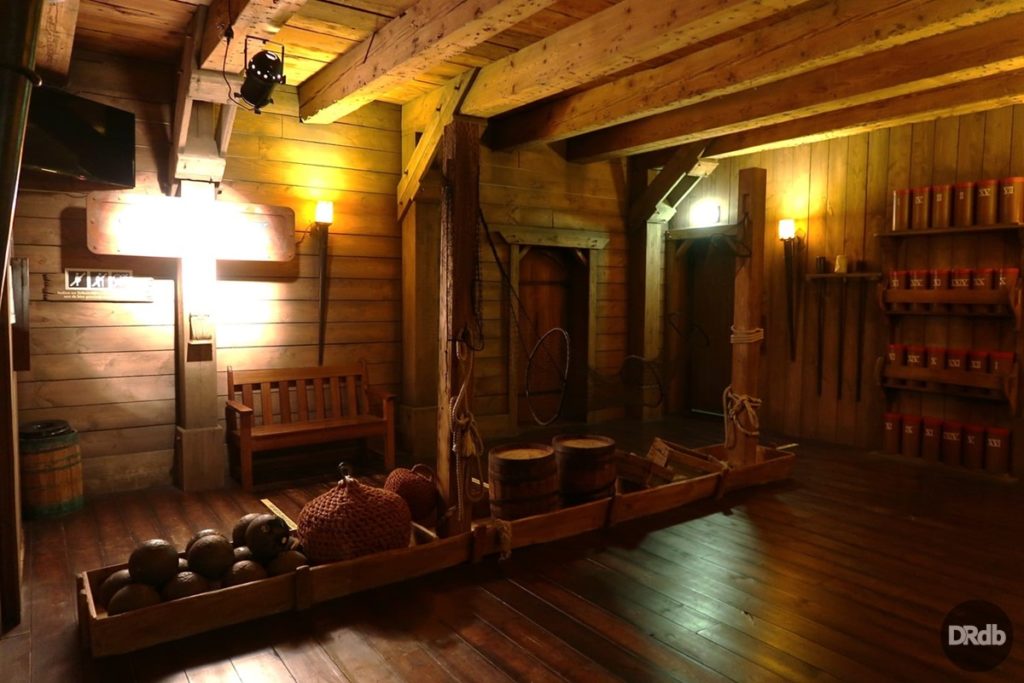
The old queue was kept and slightly reworked to more resemble a pirate ship called the Bird Galley. When peeking inside, visitors could now view pirates taking over the galley. The old pre-show found at the end of this hallway was put out of commission and guests simply walked past the (now slightly re-positioned) captain towards the new part of the queue. Later, in 2017, the Bird Galley would no longer serve as the entrance. Instead, a new entrance was constructed in the midst of the Piratenhol walkthrough, in order to draw more attention to the simulator.
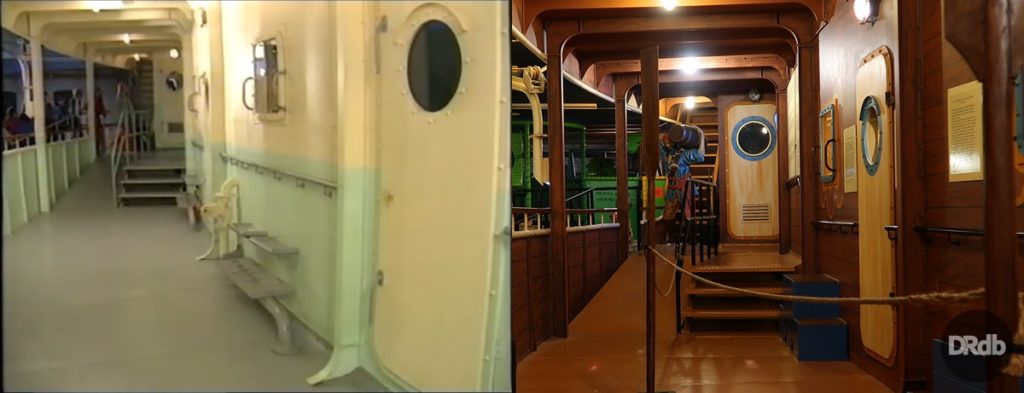
A monitor in the new queue presented a new pre-show. It featured the famous captain Blackbeard, portrayed by Dutch musician Bennie Jolink. In the live action video, Blackbeard explains some of his common practices as a fearless pirate, proudly proclaiming that he has successfully attacked all kinds of ships. So what is he getting revenge on? His arch enemy, the Spanish galleon Almiranta which he was never able to take over. Just thinking about it makes him mad.
He also goes over some famous sailors’ superstitions, like the curse of the albatross. As the story goes, albatrosses are the reincarnations of dead pirates and should be left alone at all costs. The stubborn Blackbeard is not afraid to show he doesn’t believe in these kinds of superstitions. He demands we ‘’landlubbers’’ board his ship to help him get revenge on the Almiranta, just before he storms off to scare an albatross away from his ship.

The door opens and we board the simulator from the back as we would have in 1993. The installation had received a face-lift. It now resembled a pirate ship with wooden planks, barrels and a cannon on deck. We now face a projection screen instead of the old diorama system. The 10 newly constructed benches provide seating room for about 35 passengers. The lights would dim and the 8 minute adventure could begin.

After the title screen we find ourselves in a harbour, with the boat softly rocking on some small waves. This is where we first hear Blackbeard speak; he does not actually appear in the film. Blackbeard tells his men to set sail towards the open sea, in search of the ship Almiranta. This is when the boat starts sailing towards some rocks at the end of the harbour. It takes a turn to the right to barely avoid the rocks and sets off into the open sea, while Blackbeard promises a ducat to the one that spots the Almiranta. An albatross appears and Blackbeard throws a bottle at it, exclaiming that he is not fond of ghosts on his ship. The albatross continues to fly onto the ship, whereafter Blackbeard asks for his musket, followed by the sound of a gunshot.
A storm suddenly begins, making the waves higher and higher. This was the main part of the ride where the simulator really showed what it could do with fans, water effects and the stroboscope, acting as lightning strikes, all kicking in. The ship heads straight towards some rocks during this storm, with a bolt of lightning almost striking the boat as the rocks are narrowly avoided. Night falls, but luckily the sea has returned to a calm state. Blackbeard feels the need to address that while this was a close call, he certainly does not believe in the curse of the albatross, and demands his crew to set sail again.

We quickly run into the Almiranta and Blackbeard does not hesitate to command his crew to fire the cannons. They miss and it’s now the Almiranta’s turn to retaliate. A direct hit causes our ship to shake violently and a fire (simulated with red lights and smoke) breaks out at the bow. The Spanish galleon, convinced of victory, makes a run for it. “This is our final chance!” says Blackbeard, as the cannons fire again in the nick of time. What follows is an explosion and the Almiranta slowly starts to sink to the bottom of the sea. Victory is ours!
Blackbeard is quick to forget his problems as he celebrates, not noticing the increasing amounts of smoke coming from his own ship. An albatross makes its way from the Almiranta and flies over our heads, at which point an explosion goes off, causing our ship to start sinking. Blackbeard mumbles in his final words that the albatross curse might have been real after all. The last we hear of him is a scream as he meets his watery demise. Our ship slowly sinks to the bottom of the shark infested waters and touches the seabed. Remnants of the Almiranta make up the majority of our view. As a shark lunges at us, the screen cuts to black and the credits roll.

Afterwards the lights would turn on and we would be asked to leave the ride. The simulator could now only be left at the back instead of the side, though a (former emergency exit) door led to the same hallway ending up at the bistro as before. While the story portrayed is far from historically accurate (Blackbeard certainly didn’t end up on a sinking ship), the ride was deemed a success.
2006 saw the ‘Vlootshow’ being replaced by ‘A Pirate’s Adventure’, acting as sort of a pre-show to the simulator. After this though, developments on Het Arsenaal slowed down considerably as the last noteworthy change was the restructured top floor in 2014. This featured a new exhibition and also replaced ‘A Pirate’s Adventure’ with a theatre.
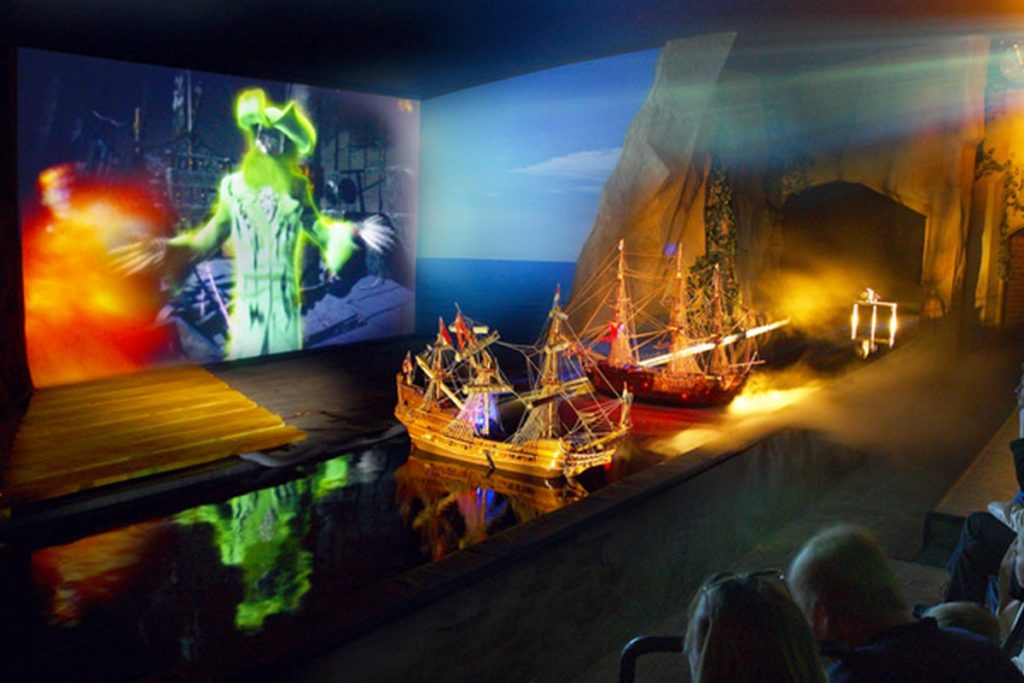
Behind the Scenes
Let us take a peek behind the scenes and find out how the installation functions. The simulator was cleverly built on the first floor so that the motoric and computer components could be easily reached from the ground floor. A seeming dead end wall in the midst of the Underwater World, themed like a rusty shipwreck, granted access backstage. The spacious technical room was an extension of the room above it, in which riders were seated.

The motion simulator was constructed by the Dutch firm Hydraudyne, nowadays known as Bosch Rexroth. Though mostly known for their boat lifts and contributions to the Delta Works (the Dutch water defense system, often cited as one of the modern Wonders of the World), Hydraudyne manufactured over 160 simulators worldwide. Most of these however are not for amusement purposes but built for flight or heavy equipment training. In order to carry the simulator’s weight of 4 metric tonnes (4,000 kilograms), it sat on a large cement foundation which in turn rested on 13 piles driven deep into the ground.

It was a relatively simple installation with just two cylinders, providing movement options for the X (roll) and Y (pitch) axis. The combined power consumption of 50 kilowatts supplied the system with the needed pressure of 210 bar. The hydraulic power unit was hidden in its own small room to keep the noise levels down. Next to it a computer was located with Hydraudyne’s custom software running on MS-DOS. It provided the current system status as well as error codes when needed. During operating hours, it was not needed to tinker with any of these systems as the ride could be started with the press of a single button on a control box upstairs.
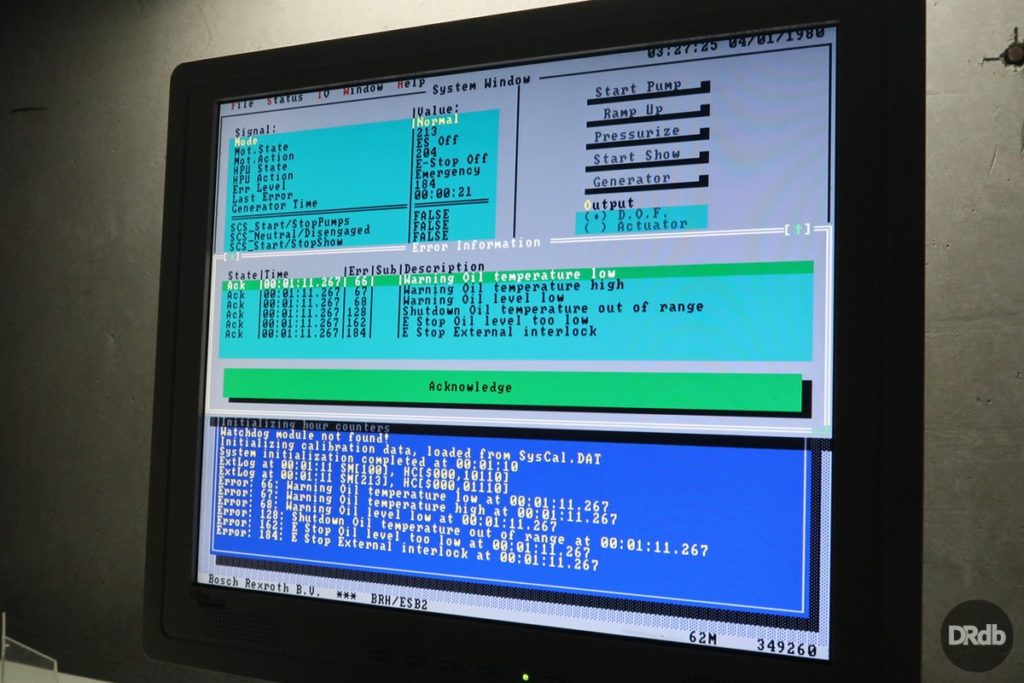
Behind the projection screen, which was actually a piece of hard plastic, was the location of a second technical room. Here the rear-projection as well as special effects were controlled from a computer. Due to the limited amount of available space, the projector was bracketed to the ground and faced the opposite way. A large mirror would then reflect the light into the screen.
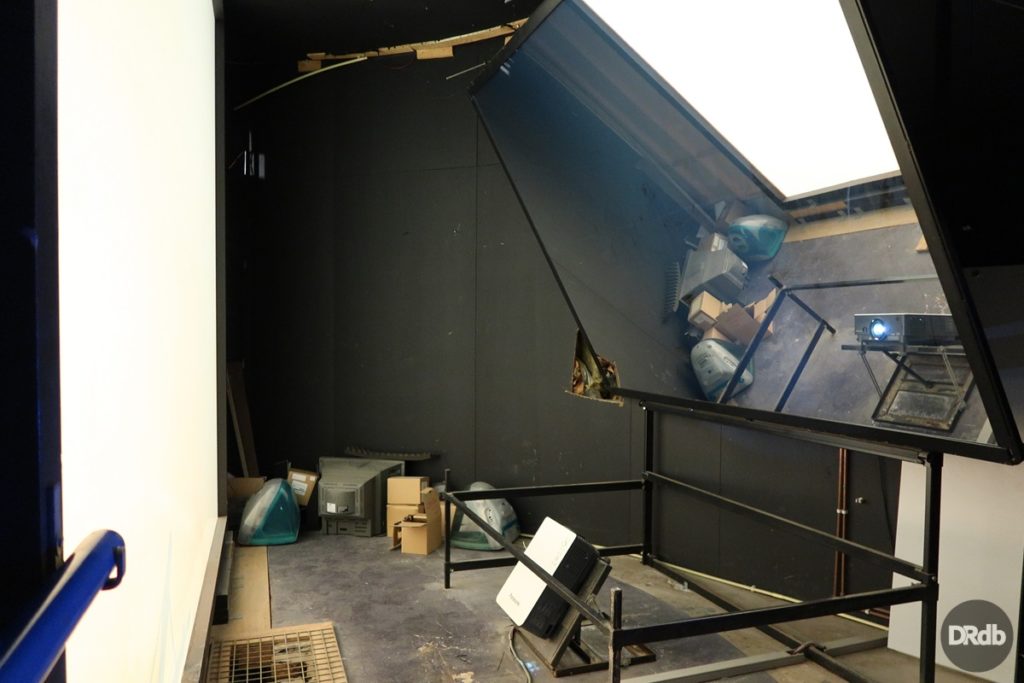
A control cabinet housed the audio mixers and amplifiers as well as a DVD player from which the movie was streamed. The individual simulator effects like the fans and smoke machine were accordingly activated by a custom program running on an iMac G3.
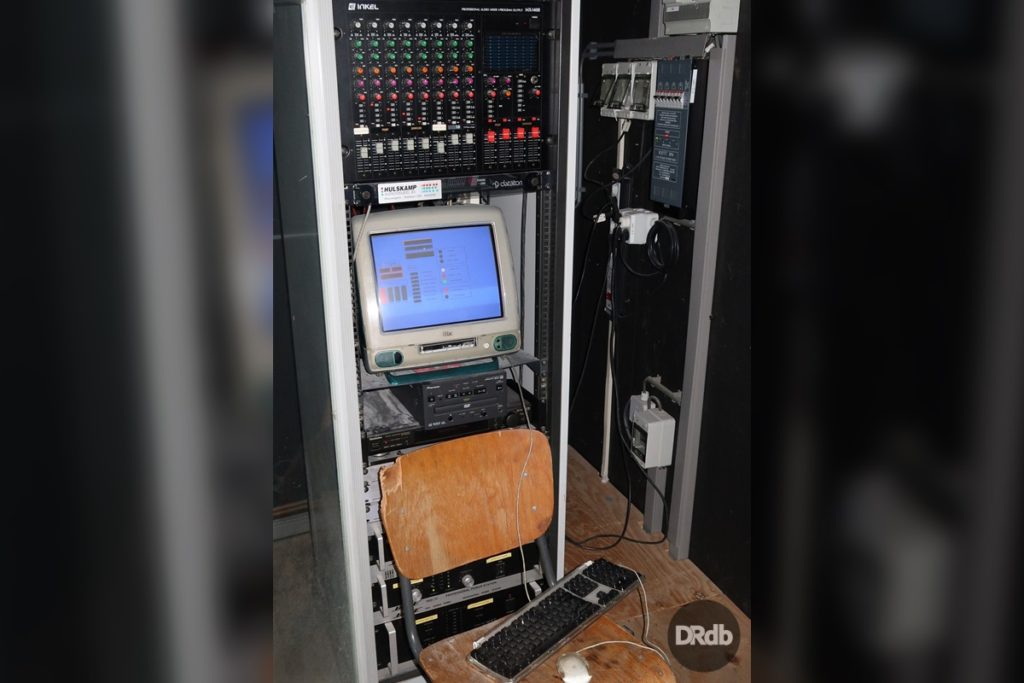
Finally we should discuss the movie itself. Wennekes Multimedia, nowadays known as Wennekes’ Office for Imagination, famous for their work on other interactive museums like Corpus (Oegstgeest, Zuid-Holland – Netherlands) and even the edutainment section of PandaDroom at Efteling (Kaatsheuvel, Noord-Brabant – Netherlands), were contracted to produce the movie. They came up with the concept and were also later responsible for A Pirate’s Adventure. To ensure historic accuracy, the team visited Het Scheepvaartmuseum (Dutch National Maritime Museum) to study old Spanish galleons. The Almirata ended up closely resembling the San Felipe, one of the largest Spanish galleons in history. They also went on a trip to film ocean waves, though none of this real life footage would be used in the animation.
Wennekes Multimedia subcontracted other studios to create the actual visual content. The live-action pre-show was produced by Radical Film & Television. One-man business Dugour Productions (back then known as Anitime) was hired to create the 3D animation. For this the LightWave 3D software was used, which coincidentally was also featured in the 1997 movie Titanic. Due to a fast approaching deadline, Wennekes Multimedia initially hired another studio to produce the storm scene but were not satisfied with the result, prompting Daniel Dugour to animate it himself at the last minute. Check out Dugour’s website for more information on the animation process as well as his other projects.
A custom soundtrack was created as well by the now defunct group The Quality Quartet. It was replaced in 2016 with a composition by Frank Engels, who by that time had become the in-house composer for Het Arsenaal.
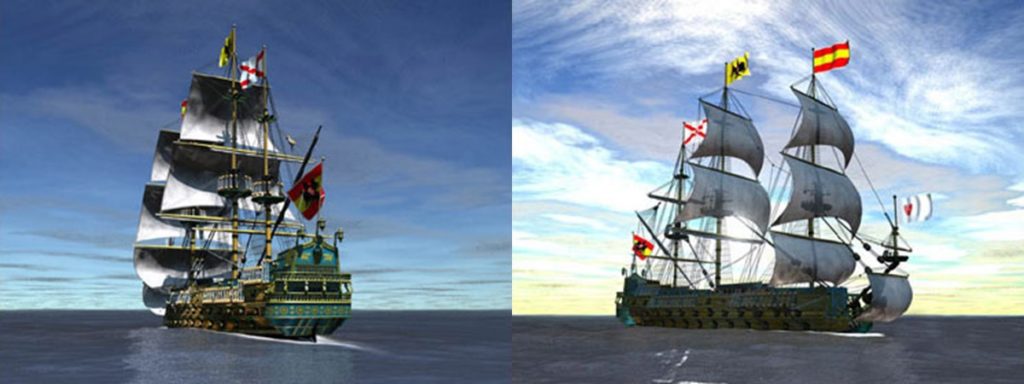
Moving Forward
Sadly by 2021, visitor levels had dropped significantly. Fierce competition from theme parks, the inability to keep up with modern times and a lack of interest by the operator caused Het Arsenaal to become more or less a time capsule. A rare relic from back when interactivity in museums and edutainment was starting to become the norm, but had not yet been perfected.
So after 28 years of operation, it was decided to close Het Arsenaal. We wish the landlord the best of luck with their plans to open a luxurious hotel on this location in 2023. Multiple parties have expressed interest in adopting the marine life, ensuring that all animals will find a new home. The simulator could potentially be sold also. So who knows, maybe Blackbeard and his crew might pop up somewhere else in the future…
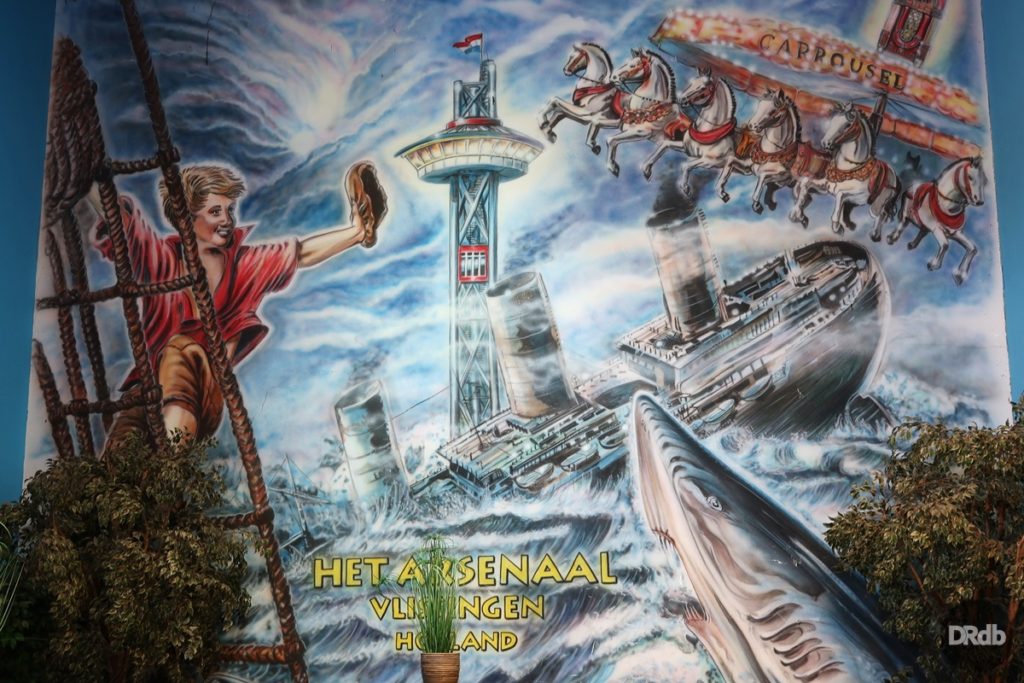
References
Archive newspaper articles (Dutch):
https://krantenbankzeeland.nl/issue/vli/1991-11-06/edition/null/page/5
https://krantenbankzeeland.nl/issue/vli/1992-04-15/edition/null/page/5
https://krantenbankzeeland.nl/issue/pzc/1993-05-18/edition/0/page/27
https://krantenbankzeeland.nl/issue/pzc/1996-03-04/edition/0/page/7
https://krantenbankzeeland.nl/issue/pzc/1996-03-04/edition/0/page/7
Het Arsenaal on Wikipedia (Dutch):
https://nl.wikipedia.org/wiki/Het_Arsenaal
Article on the opening of Het Arsenaal (Dutch):
https://vlissingendronk.nl/wiki/Maritiem_Restaurant_Het_Arsenaal
Dugour Productions:
http://dugourproductions.nl/nl/blackbeards-revenge/
Wennekes’ Office for Imagination:
https://www.officeforimagination.com/
Images courtesy of Dark Ride Database, Het Arsenaal, Zeeuws Archief, Camile Schelstraete, Foto Dert, Ben Wind, Ruben Oreel, Het Gezicht van Nederland (NCRV), Dugour Productions and Wennekes’ Office for Imagination.
Special Thanks:
Special thanks to the amazing staff at Het Arsenaal, especially Michiel (a.k.a. Piraat Pannenkoek) for sharing their stories with us and providing an exclusive backstage tour.
©2021 Dark Ride Database
Revision 1.1: December 2021
Photography by Quintus and Jim
Article by Quintus and Jim



